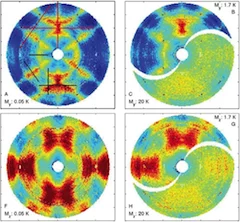Spin correlations with power-law decay are usually associated with a critical point, but stable phases with power-law correlations may exist in frustrated magnets. Such phases are interesting, because they represent model materials where short-range interactions and local constraints lead to emergent symmetries and fractional quasiparticles. For example, in a spin ice, spin configurations that respect a local ice-rule constraint give rise to dipolar (i.e., 1/r3) spin correlations and emergent magnetic monopoles. Dipolar correlations are identified in scattering experiments by the existence of distinctive sharp and anisotropic features known as pinch points. We investigated the low-temperature state of the rare-earth pyrochlore Tb2Ti2O7 using polarized neutron scattering experiments performed on TASP (SINQ) and D7 (ILL). Tb2Ti2O7 is often described as an antiferromagnetic spin liquid with isotropic spin correlations extending over lengths comparable to individual tetrahedra of the pyrochlore lattice. We confirmed this picture at 20 K but find that at 0.05 K the data contain evidence of pinch-point scattering, suggesting that the low temperature state of Tb2Ti2O7 has power-law spin correlations and may be described by an as yet unknown emergent gauge theory.


